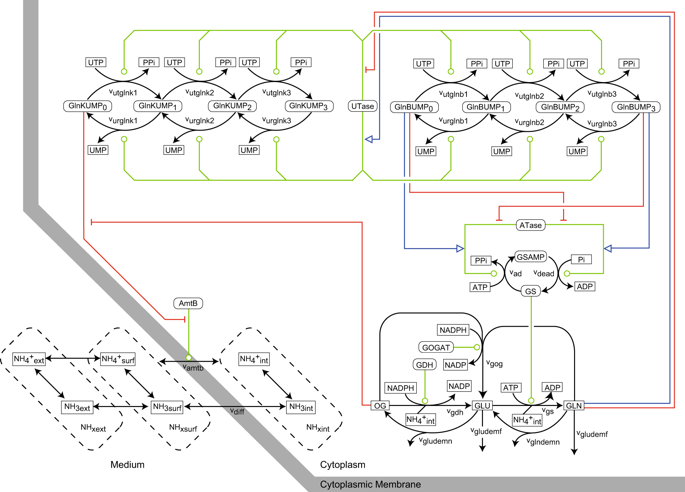当前位置:
X-MOL 学术
›
npj Syst. Biol. Appl.
›
论文详情
Our official English website, www.x-mol.net, welcomes your feedback! (Note: you will need to create a separate account there.)
Ranking network mechanisms by how they fit diverse experiments and deciding on E. coli's ammonium transport and assimilation network.
npj Systems Biology and Applications ( IF 4 ) Pub Date : 2019-04-12 , DOI: 10.1038/s41540-019-0091-6 Kazuhiro Maeda 1, 2 , Hans V Westerhoff 3, 4, 5 , Hiroyuki Kurata 2, 6 , Fred C Boogerd 3
npj Systems Biology and Applications ( IF 4 ) Pub Date : 2019-04-12 , DOI: 10.1038/s41540-019-0091-6 Kazuhiro Maeda 1, 2 , Hans V Westerhoff 3, 4, 5 , Hiroyuki Kurata 2, 6 , Fred C Boogerd 3
Affiliation

|
The complex ammonium transport and assimilation network of E. coli involves the ammonium transporter AmtB, the regulatory proteins GlnK and GlnB, and the central N-assimilating enzymes together with their highly complex interactions. The engineering and modelling of such a complex network seem impossible because functioning depends critically on a gamut of data known at patchy accuracy. We developed a way out of this predicament, which employs: (i) a constrained optimization-based technology for the simultaneous fitting of models to heterogeneous experimental data sets gathered through diverse experimental set-ups, (ii) a 'rubber band method' to deal with different degrees of uncertainty, both in experimentally determined or estimated parameter values and in measured transient or steady-state variables (training data sets), (iii) integration of human expertise to decide on accuracies of both parameters and variables, (iv) massive computation employing a fast algorithm and a supercomputer, (v) an objective way of quantifying the plausibility of models, which makes it possible to decide which model is the best and how much better that model is than the others. We applied the new technology to the ammonium transport and assimilation network, integrating recent and older data of various accuracies, from different expert laboratories. The kinetic model objectively ranked best, has E. coli's AmtB as an active transporter of ammonia to be assimilated with GlnK minimizing the futile cycling that is an inevitable consequence of intracellular ammonium accumulation. It is 130 times better than a model with facilitated passive transport of ammonia.
中文翻译:

根据网络机制如何适应不同的实验对网络机制进行排名,并决定大肠杆菌的铵运输和同化网络。
大肠杆菌复杂的铵转运和同化网络涉及铵转运蛋白AmtB、调节蛋白GlnK和GlnB以及中央N同化酶及其高度复杂的相互作用。对如此复杂的网络进行工程和建模似乎是不可能的,因为其功能很大程度上取决于已知的各种精度不一的数据。我们开发了一种摆脱这种困境的方法,它采用:(i)基于约束优化的技术,用于将模型同时拟合到通过不同实验设置收集的异构实验数据集,(ii)“橡皮筋方法”处理不同程度的不确定性,包括实验确定或估计的参数值以及测量的瞬态或稳态变量(训练数据集),(iii)整合人类专业知识来确定参数和变量的准确性,(iv)使用快速算法和超级计算机进行大规模计算,(v)量化模型合理性的客观方法,这使得可以确定哪个模型是最好的以及该模型比其他模型好多少。我们将新技术应用于铵传输和同化网络,整合了来自不同专家实验室的各种精度的最新和较旧的数据。动力学模型客观上排名最佳,大肠杆菌的 AmtB 作为氨的主动转运蛋白,与 GlnK 进行同化,最大限度地减少无效循环,而无效循环是细胞内铵积累的不可避免的结果。它比促进氨被动运输的模型好 130 倍。
更新日期:2019-04-12
中文翻译:

根据网络机制如何适应不同的实验对网络机制进行排名,并决定大肠杆菌的铵运输和同化网络。
大肠杆菌复杂的铵转运和同化网络涉及铵转运蛋白AmtB、调节蛋白GlnK和GlnB以及中央N同化酶及其高度复杂的相互作用。对如此复杂的网络进行工程和建模似乎是不可能的,因为其功能很大程度上取决于已知的各种精度不一的数据。我们开发了一种摆脱这种困境的方法,它采用:(i)基于约束优化的技术,用于将模型同时拟合到通过不同实验设置收集的异构实验数据集,(ii)“橡皮筋方法”处理不同程度的不确定性,包括实验确定或估计的参数值以及测量的瞬态或稳态变量(训练数据集),(iii)整合人类专业知识来确定参数和变量的准确性,(iv)使用快速算法和超级计算机进行大规模计算,(v)量化模型合理性的客观方法,这使得可以确定哪个模型是最好的以及该模型比其他模型好多少。我们将新技术应用于铵传输和同化网络,整合了来自不同专家实验室的各种精度的最新和较旧的数据。动力学模型客观上排名最佳,大肠杆菌的 AmtB 作为氨的主动转运蛋白,与 GlnK 进行同化,最大限度地减少无效循环,而无效循环是细胞内铵积累的不可避免的结果。它比促进氨被动运输的模型好 130 倍。


























 京公网安备 11010802027423号
京公网安备 11010802027423号